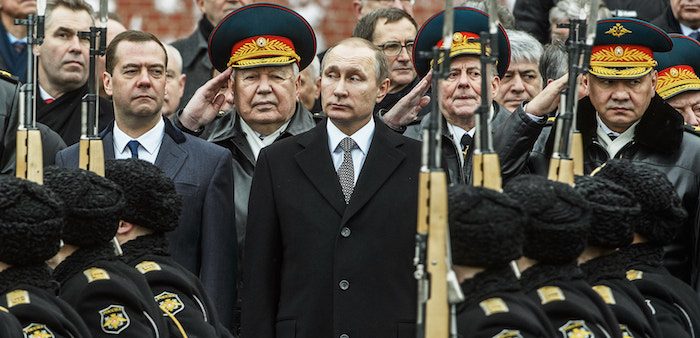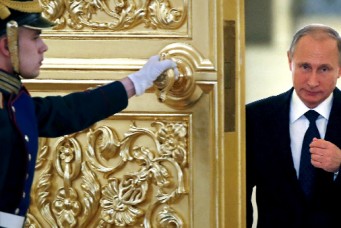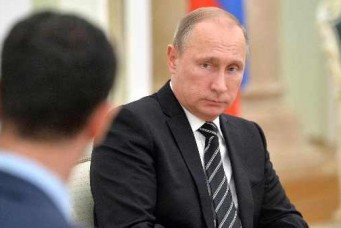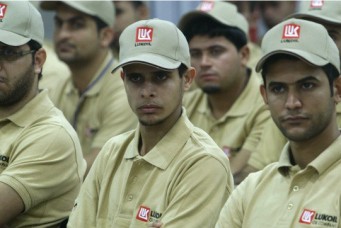Unraveling in the Kremlin
Vladimir Putin intervened in Ukraine and Syria to mobilize domestic support for Russia’s decaying political system. But how long can the Kremlin survive on false images, fake agendas, and manufactured complexes?

President Vladimir Putin at the Tomb of the Unknown Soldier, Moscow, Feb. 23, 2016. Dmitry Azarov/ Kommersant/Getty Images
President Vladimir Putin has found a new model for Russia’s political survival in the post-Communist era. It could be defined as “To be with the West, to be inside the West, and to be against the West.” Depending on its survival needs, the Kremlin has been alternating emphasis on various elements of this model. Through 2007, cooperation and partnership with the West were the Kremlin’s priorities. After Putin’s return to the Russian presidency in 2012, the Kremlin pursued a more assertive foreign policy, with the annexation of Crimea and war with Ukraine in 2014. Since then, even amid the Russian intervention in the Syrian civil war in 2015, the Russian leadership has sought a balance between containment and dialogue.
Foreign policy has become a crucial instrument for perpetuating the Russian system and securing the interests of the Russian ruling class. In this regard, it serves overlapping functions. It pursues the goal of justifying the Besieged Fortress model for Russia that has to generate internal support for personalized power in the situation of failure to guarantee effective social and economic policy. And at a time of shrinking internal resources and economic recession, Russian foreign policy seeks to mobilize society and create military-patriotic legitimacy for the regime. The fact that foreign policy has to perform such internal functions, usually the domain of social and economic policies, indicates that the Russian system has lost its equilibrium and sustainability. However, shifting people’s attention from internal problems to issues like the global balance of power, the perceived Western attempts to humiliate Russia, and preparations for war with neighbors suggests illusionary solutions that will likely deepen Russia’s civilizational quagmire.
Today Putin’s Kremlin is employing a three-track foreign policy vis-à-vis its Western partners to assert Russia’s role as a key geopolitical actor. The policy seeks to cooperate with the West (but on Moscow’s terms); integrate the Russian rentier class into the Western community; and contain the West. Containment is reflected in the regime’s efforts to block Western norms, such as the passage of laws that bar civil society from receiving financial aid from the West. All non-governmental organizations (NGOs) that until recently were receiving such aid have to be registered as “foreign agents.” Anti-Western and primarily anti-American propaganda is another effective means of counteracting Western influence and mobilizing the population behind the Kremlin.
The Kremlin is not ready to seal the borders completely and return to the Cold War standoff with the West. There are various factors encouraging cooperation with the West as well as constraining the Kremlin’s aggressiveness: the interests of the comprador elite; Russian economic interests, including dependence on the sale of hydrocarbons to Europe and dependence on Western investment and technology; the understanding that Russian military and economic resources would be limited in the event of a confrontation with the West; the biting effect of the current Western sectoral sanctions and the threat of new sanctions; the fear of losing control over escalating domestic tensions; and the absence of genuine external threats to the regime.
These factors steer Putin toward dialogue with the West, but with the Kremlin setting the modalities. Among the Kremlin’s demands: don’t meddle in Russian domestic life; accept Russian “spheres of influence”; halt NATO expansion in the direction of Russia’s borders; bar deployment of NATO forces in Eastern European and Baltic states; stop inviting post-Soviet states into the European Union (EU); accept Gazprom’s monopoly in the European energy market; recognize Russian interests in the Arctic; bow to the Kremlin’s understanding of the international rules of the game; and accept Russia in the role of “equal” partner.
Russia’s bellicosity and saber-rattling are misleading. Despite the anti-Western hostility and even nuclear blackmail the Kremlin has recently put on display, it is ready to experiment with various forms of engagement, cooperation, and even partnership with liberal democracies. It hopes that the lack of unity in the West will enable Russia to pursue its policy of divide and rule, create loyal allies within the West, and enable Russia to use cooperation for its own interests.
The Kremlin has turned provoking and managing conflict into an art form. It has skillfully played states against one another; co-opted Western elites and penetrated Western organizations in consolidating support within the West; and sparked crises allowing it to often play several roles at the same time—spoiler, intermediary, intruder, and peacemaker. Putin’s elite has managed to go beyond the practice of containment to influence Western decision-making in Russia’s favor—for example, torpedoing the movement of Ukraine, Georgia, and Moldova toward Europe; forcing European leaders to accommodate the Kremlin’s energy policy; winning Western acquiescence for its military incursion into Syria and even for President Bashar Al-Assad’s continuation in power; and creating a powerful business lobby and coopting representatives of the expert community in Western countries (through participation in Kremlin forums like Valdai Discussion Club).
One can’t ignore the tenacity of the Russian leadership in exploiting Western weakness and disunity. It well understands the current dysfunction of the liberal democratic model: the West’s lack of readiness for new ideological projects and downplaying of the normative dimension in foreign policy; how the comfortable status quo in post-modern Europe discourages political will and quick reaction, lacking any ambition and moral strength for containment and confrontation; America’s willingness to backslide on commitments, and Barack Obama’s “do-nothing” retrenchment policy.
Even in cooperation, Putin’s Kremlin will not mellow. The Russian elite and part of the population interpret the Kremlin’s anti-Western aggressiveness as evidence of power and prowess; thus, any retrenchment will be perceived as a sign of the regime’s—and leader’s—weakening. The still-influential military industrial complex will demand that the state stick with the militarization model. Much of the Russian population has become mobilized and is still willing (albeit with much less eagerness) to compensate for its pathetic living standards by accepting the claims of Russia’s greatness, even if the claims are nothing but bluff. All these factors will set Russia’s militarist and imperial behavioral pattern on the world stage unless the Russian system is transformed.
The Ukrainian Deadlock
In the Ukraine crisis, Putin knocked over the geopolitical chessboard. The crisis arose in February 2014 when Euromaidan protesters succeeded in ousting President Vicktor Yanukovych for blocking Ukraine’s association agreement with the European Union. The Kremlin fueled pro-Russian separatism in eastern Ukraine and then launched military interventions, which led to the Russian annexation of Crimea and the war in the Ukrainian Donbass. Negotiations between Germany’s Angela Merkel and France’s François Hollande on one side and Putin and Ukraine’s Petro Poroshenko on the other led to the Minsk II agreements on February 11, 2015. The West and Russia offered a hybrid solution to a hybrid conflict, which sowed the seeds of future problems. First, Russia was accepted as a peacemaker and broker, and its demands were allowed to become the framework for the truce. Second, Western negotiators under Moscow’s pressure agreed to turn the war and peace issue into a discussion of Ukrainian statehood, in this way giving consent to limit Ukraine’s sovereignty. It was an attempt to strike a compromise between incompatible interests and antagonistic postures—between Ukraine’s decision to move toward Europe and the Kremlin’s determination to keep Ukraine in its tight embrace.
The West became engaged in the Ukraine negotiations believing in the force of arguments, rationality, the power of persuasion, and the mechanism of give-and-take, and looking for a win-win result. Russia got involved and even initiated the process striving for something else: a deal to preserve its military gains and secure control in Ukraine, and to win the West’s endorsement of the Kremlin’s interpretation of the global game. James Sherr of the British-based think tank Chatham House gave the most devastating analysis of the Minsk II accord: “Instead of a diplomatic process reinforced by Western pressure, we have ended up with a series of political retreats under Russian pressure.”
All sides in the Ukraine crisis had their own agendas. When Moscow learned that Ukrainians were ready to fight back and that Russian intervention would be bloody, the Kremlin dropped the Novorossiya (New Russia) project of splitting the Ukrainian state and creating an enclave loyal to Moscow that would include the industrial regions of Kharkiv and Dnipropetrovsk. The Kremlin had to limit its agenda to the less ambitious plan to preserve two Donbass separatist “republics” as an instrument to undermine Ukraine from the inside.
Ukraine, for its part, has demonstrated both a strong desire to move toward integration with Europe and an inability to do so without assistance from the West. Western negotiators apparently hoped that military de-escalation along with sanctions would result in a political solution, and decided to insist on concessions from both sides of the conflict. The absence of the United States in the negotiations, which would have added military muscle to Europe’s soft power, limited the West’s leverage.
Minsk II apparently was the best the West could achieve following a model of “sanctions plus diplomacy” with America playing an observer role (having outsourced the Ukraine crisis to Germany). To the surprise of many and to Moscow’s shock, Merkel, Minsk II’s key Western architect, put aside Germany’s traditional Ostpolitik cooperation with Russia and enforced European unity on economic sanctions against Russia. On the other hand, Germany revealed the limits of the West’s readiness to confront Russia and of Europe’s capacity to solve its security problems. The Minsk process allowed the West to save face and de-escalate tensions, but it did not yield a sustainable resolution.
The Ukraine crisis remains deadlocked. Despite the military de-escalation, the truce is constantly broken and mainly by the separatists, and the outbreaks of fighting have taken hundreds of lives. Moreover, Moscow has used other means to undermine the Ukrainian state: trade boycotts, “energy diplomacy,” the manipulation of prices to exert political pressure, and other coercive economic mechanisms deriving typically from Russia’s use of the old Soviet patterns of imperial leverage. At the same time, the West could not completely surrender Ukraine to Moscow. That would expose the abandonment of its principles and amount to acknowledgment of defeat, factors that could tempt illiberal states to test their power further. The new American sanctions on Russia in December 2015 for not complying with Minsk II, as well as the extension of EU sanctions through the end of 2016, showed how the West blames Moscow for the continuing crisis.
Bursts of infighting in Donbass through 2016 illustrated the determination of the Kremlin and its proxies to force the Ukrainian government into accepting Russia’s terms for an end to the conflict. Moscow demands that the Ukrainian government endorse a “special” status for two separatist enclaves and legitimize their virtually independent status in the constitution. The Kremlin also insists that Kiev agree to elections on the separatists’ terms, which would create within Ukraine hostile entities subordinate to Moscow but financed by Ukraine. Ukrainian reading of the Minsk agreement is different: Kiev puts an emphasis on the “security package”—withdrawal of all Russian troops and armaments from Donbass and the return of the Ukrainian control over the border, and only after that elections according to Ukrainian law. Real peace is certainly not possible without sealing the open border between Ukraine and Russia that allows Moscow to support separatists with weapons and send Russian troops into Ukrainian territory.
The West is not ready to see the conflict escalate toward a new war—much less to fight for Ukraine. It often looks as if Western leaders are playing along with Putin’s “let’s pretend” game that Russia wants peace, and have been trying to persuade the world (and themselves) that Minsk II will bring a sustainable truce. Ukraine has to pretend, too, that it follows the contradictory Minsk agreement and remains neither at war nor at peace. A broadly shared willingness to pretend hardly makes for a durable peace settlement. So far nobody is prepared to push the necessary strategic breakthrough. But the patience in the West is running out and it is more inclined to pressure Russia to stop militarization of the conflict.
The impression is that all sides hope to freeze the conflict, leaving it open for a future solution. The question is what form the freezing is taking. One possibility is a Ukrainian version of Transnistria, financed by Russia, which would mean that the Ukrainian separatists will be forcibly integrated into Ukraine and financed by the Ukrainian state. This is a scenario for a Finlandized Ukraine, left dangling between Russia and Europe, which would be the equivalent of planting a bomb inside Ukraine and leaving the trigger in the Kremlin’s hands. And Ukraine would hardly agree to this option. But what could be another option of freezing the conflict remains unclear.
Syrian Gambit
“We are shocked!” This has been the leitmotif of Western responses to Putin’s intervention in Syria that began in September 2015. Moscow’s official explanation for the Syrian foray is hardly persuasive: Putin is fighting international terrorism that could come to Russia. The reality is that the Syrian intervention only increased Russia’s vulnerability to terrorism. Some of the conventional wisdom about Putin’s logic is persuasive on its face; for example, that Putin sees it as a means to strengthen Russia’s superpower role and safeguard Moscow’s sphere of influence in the Soviet tradition. Yet, why would Putin choose to flex Russia’s muscles in Syria, where failure is virtually guaranteed? And why would he do so in 2015, when Russia was already reeling from economic shocks caused by sanctions and the fall in the price of oil? The Kremlin isn’t ruled by a kamikaze. Some analysts argued that Putin wants to save Syrian President Bashar Al-Assad. This explanation suggests that the Kremlin has some sort of strange sympathy for Syria’s leader. Putin surely understood that he could never justify this motivation at home—especially at the time when Al-Assad’s regime seemed to be on the verge of collapse.
I would argue that Putin intervened in Syria to distract attention from Russia’s war in Ukraine, and to downgrade the Ukrainian conflict. That is an admission of Russia’s failure to expand further into southeast Ukraine and tighten its grip on the country. Another aim of the Syrian intervention was to break out of diplomatic isolation and return to business as usual with the West. That is an admission that Western sanctions were biting. Even more important, Putin understood that isolation does not allow Russia to play the superpower role that remains a crucial pillar of the Russian system of personalized power. Al-Assad’s destiny, oil, military bases, and the balance of power in the Middle East are all factors in achieving this end. Timing was also a critical factor: Europe was consumed with financial and refugee crises, and America’s lame duck president was not looking for another confrontation with Russia. As Zbigniew Brzezinski wrote, “One might have thought . . . that the next phase in coping with the Syrian problem might involve a renewed effort to resolve it . . . Instead, Moscow has chosen to intervene militarily, but without political or tactical cooperation with the U.S. . . . At best it was a display of Russian military incompetence; at worst, evidence of a dangerous desire to highlight American political impotence.” I would add another explanation: Putin’s frustration with Obama’s rejection of a Grand Anti-Terrorist Coalition on the Kremlin’s terms.
The Kremlin announced the withdrawal of Russia’s “main forces” from Syria in March 2016, which proved a deceit, and by August had begun bombing raids over Syria staged from an Iranian airbase. In September, Russian military aircraft joined Syrian regime forces in a massive bombardment against rebels in Aleppo that produced civilian carnage, prompting Washington to accuse Russia of atrocities and suspend talks with the Kremlin on Syria.
The Syrian intervention helped the Kremlin to reassert its superpower role, to return to its dialogue with the West, guarantee its military bases in Syria, put the Ukrainian conflict on the back burner, and persuade the West of its ability to be a spoiler. Yet, the Syria adventure is an extension of the thinking that led to the collapse of the Soviet Union: Russia must remain a global superpower at any price, but the current resources do not allow Russia to continue this gambit indefinitely. Putin’s gamble has paid off so far, but perhaps only because the Russian population is busy struggling to make ends meet, and the West is preoccupied if not paralyzed by its own myriad problems.
World Disorder
The Ukraine crisis and Syrian intervention must be seen in the context of the Kremlin’s new international agenda. The key challenge for Russia, Putin declares, is “the geopolitical struggle” and the need to establish “common rules” based on “international law.” In essence, Putin wants a renewed dialogue with the West about the destiny of the world. The consternation over America’s “pivot” to Asia and the fairytales about the BRICS countries becoming a new pole of geopolitical influence are part of an effort to persuade the West to reengage with Moscow.
Putin’s blueprint of the new world order is intentionally vague. He has constantly floated the idea of another Yalta settlement, a throwback to the conference of Stalin, Roosevelt, and Churchill that legitimized areas of influence following World War II. But can Putin possibly believe that Eastern Europe can be returned to the Russian sphere of influence? Does he imagine Western capitals, with the cooperation of Iran and the Arab Sunni countries, agreeing with Moscow to divide the Middle East into Western and Russian zones? As Andrew Wood, the former British ambassador to Russia, wrote in a 2015 working paper for Germany’s Federal Academy for Security Policy, any new security architecture “would require some common understanding of the underlying facts . . . That is now absent between Russia and the West.” Besides, Wood adds, such construction “would also require some degree of confidence between the leaders of counties trying to build such a system, and that too is now absent.”
Putin’s quest for a new world order seems to be another game of “let’s pretend”—a scheme intended to draw the world into an endless dialogue with Moscow about the future of the universe and thereby keep Russia in the forefront of the geopolitical game.
There is a tradition in Russian political culture of “coercive dating”—that is, ramping up pressure in order to force the object of desire into a dialogue. Minsk II and the Syrian adventure follow the pattern. The accord with Merkel and Hollande, which tacitly accepted Russia as both an aggressor and a mediator in the conflict, gave the Kremlin the impression that the West will sooner or later endorse Russia’s vision of a new world order where each player is allowed to interpret the rules of the game as he wishes.
This ambiguous order is the best environment for Russia’s rentier class to maintain its links with “Londongrad” while also insulating Russian society from Western idealism; it would also allow the Russian regime to base its domestic legitimacy on anti-Westernism while keeping its seat at the table in the West’s institutions of international governance. This order would allow the Russian system to contain the West without worrying about the threat of containment. This would be a comfortable order for many in the West, too—for those who loathe the normative dogmatism, or who have grown accustomed to the seductive (and profitable) pragmatism in dealings with Russia over the past few decades.
Russia can’t fully return to a Cold War posture. The Kremlin understands that the country lacks the resources to compete with the West. Russia’s rent-seeking elite, its wealth bound up with globalization, can’t survive without the West. And Russia’s population doesn’t want to live perpetually in a military camp anymore.
Yet, nor can the Russian system prolong itself by imitating a liberal democracy. Even partial liberalization and renewed hopes for Russia’s integration into the West would undermine the Kremlin’s military-patriotic legitimacy. Reopening channels of dialogue and restoring freedom to society would seriously undermine a regime that depends on a closed domestic order and foreign threats to maintain control. The dilemma of the Russian system is that it cannot endlessly rely on the centuries-old cycle of militarization, but it cannot survive in peacetime either.
Ironically, over the past hundred years, starting with the Bolshevik revolution, Russia has been dependent on the West for its own survival. The Soviet Union built its legitimacy around the containment of liberal democracy. After the Soviet collapse, Russia turned to imitating the West as its source of revival. Now it has returned to deterring the West once again. This oscillation of survival models—first one, then the other, and now back to the first—should allow us to conclude that the Russian system of personalized power has lost its sustainability. How long can Russia go on like this, keeping a lid on society by feeding it with false images, fake agendas, and manufactured complexes?
It is difficult to predict Russia’s future course, but what we can say with certainty is that the Russian system can’t modernize itself. How else to explain this sudden turn to wars, this schizophrenic search for an enemy when no one is really threatening Russia inside and outside, and the impulse to lash out at anyone or anything who dares to disagree with Moscow and even at those who are afraid to disagree?
The conflict in Ukraine has turned out to be a geopolitical and civilizational clash of great magnitude, and its outcome will tell us how the Russian system will act to prolong its life. Will Russia agree to curb its geopolitical hunger and look for domestic remedies to its growing internal weakness? Or will it continue to invent new adventures with which to keep its adversaries off balance? The eventual outcome will reveal the role the West will play in determining Ukraine’s future trajectory as a European-leaning nation or a country locked within the Russian orbit. More profoundly, the outcome will tell us a great deal about the shaping of European and world order.
Lilia Shevtsova is an associate fellow at Chatham House’s Russia and Eurasia Programme. She was previously a nonresident senior fellow at the Brookings Institution’s Foreign Policy Program from 2014 to 2016. From 1995 to 2014, she was a senior associate of the Carnegie Endowment for International Peace in Moscow. She is the founding chair of the Davos World Economic Forum’s Global Council on Russia’s Future. Her books include Yeltsin’s Russia: Myths and Reality; Putin’s Russia; and Russia: Lost in Transition: The Yeltsin and Putin Legacies.





